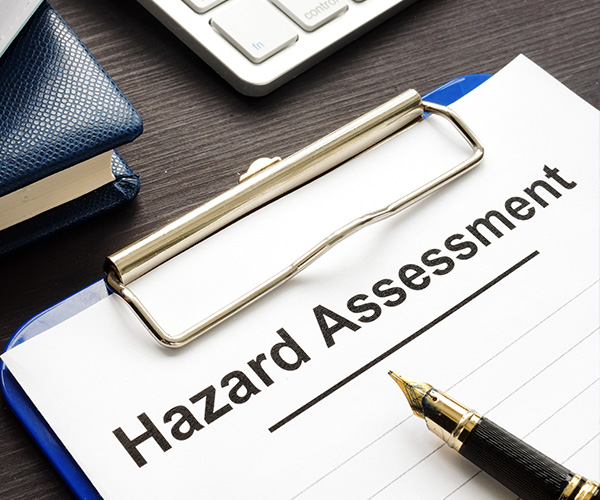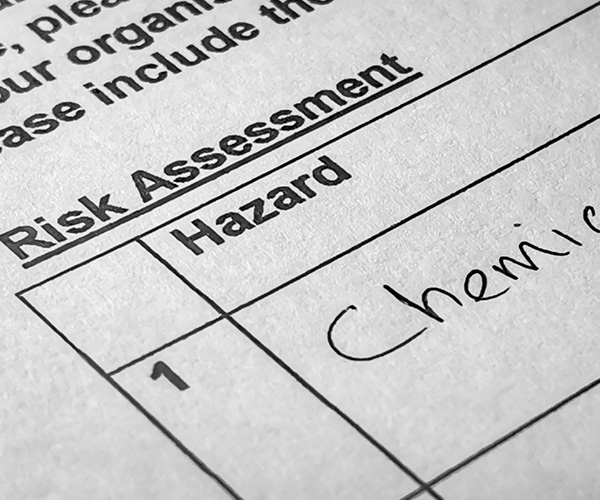HEALTH, SAFETY & ENVIRONMENT
Hazard Assessment
A hazard assessment identifies health, safety and environmental hazards and evaluates the risks associated with tasks or activities. At MacEwan, a hazard assessment should be completed for all work that has the potential to cause injury or illness.
Conduct a hazard assessment before beginning new tasks or roles, whenever there are changes to ongoing work and/or regularly to ensure safe and healthy working conditions are maintained.
Assessment process
The Hazard Assessment and Control Report form can be completed by a group (i.e., everyone involved in an activity or working in a position). However, one person must be designated as the lead who ensures the form is completesand submits it to the responsible manager for approval.
HAZARD ASSESSMENT AND CONTROL REPORTIdentify all tasks related to a position or process and list them in Column 1 of the Hazard Assessment and Control Report form. Your list should be as comprehensive as possible and include daily, monthly, annual and occasional tasks.
The sample Hazard Assessment and Control Report forms below outline task ideas and give a sense of the details you may want to include.
In Column 2, identify the physical, chemical, biological or psychological hazards related to the task(s) you listed in Column 1. Draw from the list of the most common potential campus hazards below first.
List of potential campus hazards
For obviously high hazards activities (e.g., working at height), an independent, task-based Hazard Assessment and Control Report form must be completed.
Hazard controls are measures that are implemented to eliminate or reduce the risks associated with a hazard. In Column 3, identify and list the type of control measure(s) that will be implemented to minimize risk.
There are four control types:
- Elimination/Substitution: This type of control removes the hazard by eliminating the task, changing the work process or modifying the chemical (using its substitutes or isolates).
- Engineering: This type of control eliminates the hazard by modifying the equipment, installing enclosures, installing guards or ventilating the hazard (e.g., fume hood).
- Administrative: This is a process of controlling hazards through training or developing policies, procedures and standard operating procedures/practices.
- Personal Protective Equipment (PPE): PPE is equipment or clothing worn by a worker to minimize exposure to specific hazards. Examples of PPE include medical masks, respirators, protective suits, and head, eye and foot protection.
Learn more about PPE
In Column 4, provide detailed information about the control measure(s) that will be implemented for each control type listed in Column 3.
For more information on potential hazards, control types and control measures, take the Hazard Assessment and Control course on mêskanâs.
COURSE
This course provides comprehensive training regarding hazard assessments and teaches you to identify, assess and implement hazard controls. This course is recommended for all MacEwan employees and mandatory for all research students.
 Enrol
Quick guide for self-enrolment
Enrol
Quick guide for self-enrolment
COURSE
Equip yourself with the knowledge and tools needed to create a safe and secure environment for your team. Gain valuable insights into your role in identifying, managing and controlling hazards within your area of responsibility. Discover how to navigate the hazard assessment process effectively and ensure compliance with documentation requirements.
 Enrol
Enrol
Concerns
If you have a concern related to a biological, chemical, physical or psychological hazard, such as a pool of water in a hallway, an unidentified spill in a laboratory or a dislodged fire extinguisher, it is important to report it before an incident can occur.
If you are an employee, discuss your concern with your immediate supervisor and then report it using the Employee Health and Safety Concern Report form. If the issue cannot be resolved by your immediate manager/supervisor, they will forward the completed form to the area’s Joint Work Site Health and Safety Committee (JWHSC) for resolution.
If you are a student, report to Security Service’s non-emergency line by calling 780-497-5554.
